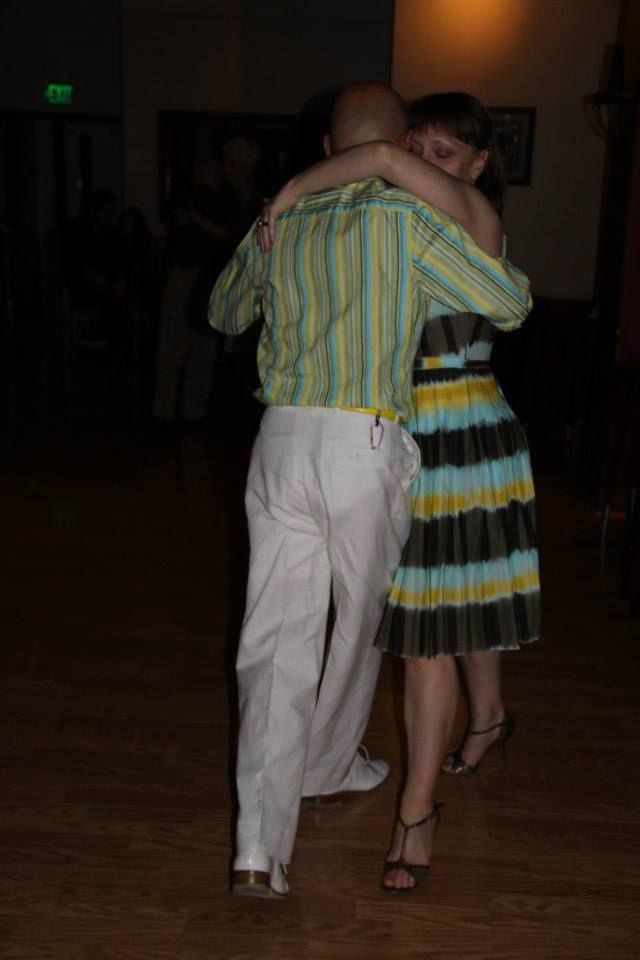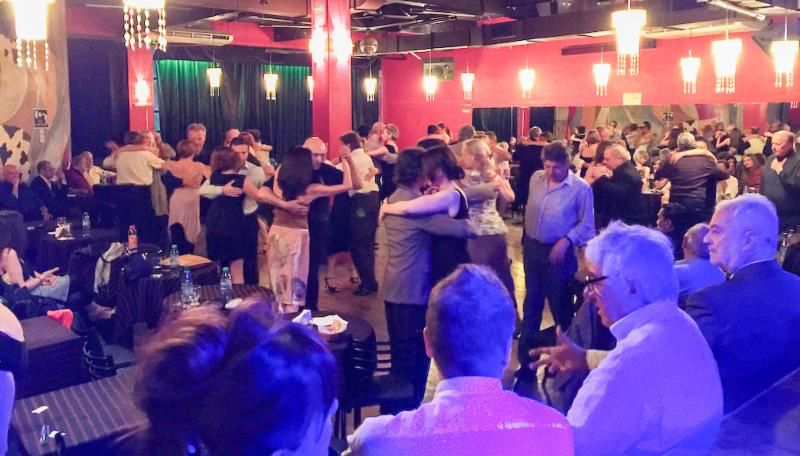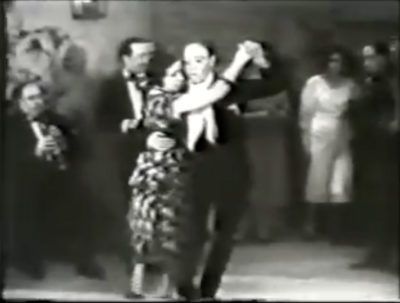 Argentine Tango is a dance that originated in the poor neighborhoods of the largest cities in Argentina and Uruguay at the end of the XIX century.
Argentine Tango is a dance that originated in the poor neighborhoods of the largest cities in Argentina and Uruguay at the end of the XIX century.
It represents the cultural mix of immigrants and the established population. For example, in the 1800s, Buenos Aires and Montevideo had a population of 25 % to more than 50 % of Africans each. They were servants of the most influential families in these cities. They were more integrated into the life of these families and society in general than the Africans of other societies like North America.
“Tangos” was called the black people celebrations and places of meeting since the beginning of the XIX century. It is in these places where the dance known today as Tango began the development of its choreography and music.
Other African terms directly related to Tango are “milonga” and “candombe”. “Milonga” is a Quimbanda expression that means “words” and referred originally to a kind of duel between two countryside singers called “payadores” who playing guitar, will improvise verses of eight syllables with a structure-type question/answer. At the same time, “candombe” is a Bantú word that referred initially to the rhythms and dances made by the Africans in their tango meetings and to these meetings.
When they were given freedom (1853), they created several associations -kinds of unions- to help themselves, and placed them mainly in the area of the neighborhood of Montserrat. During the carnival, they used to go out on the streets with brightly colored costumes and big-feathered hats, dancing many hours to the monotonous rhythm of “candombe”— the music they played at these events. Different associations competed for supremacy, which developed into bloody street incidents.
The repetition of the violence forced the police to close many of those associations in 1877. It was the end of black people’s carnival. The consequence was the creation of several dance centers where they developed a kind of couple dance called “tango” using the same choreographic elements they used before in their candombes. But that Tango was not an embraced couple dance. They danced it separately.
Other influence in the origins of Tango comes from a typical character of the Argentine Pampas: the “gaucho”.
 The “gaucho” is the product of the mix between the first Spanish who arrived in the lands later called Argentina and the natives. They were very skillful in the techniques needed to survive in the countryside. They liked to live far away from populated cities and towns, had no regular jobs, occasionally got hired by the owners of the “estancias” (farms), and knew the secrets of knife fencing and horse riding.
The “gaucho” is the product of the mix between the first Spanish who arrived in the lands later called Argentina and the natives. They were very skillful in the techniques needed to survive in the countryside. They liked to live far away from populated cities and towns, had no regular jobs, occasionally got hired by the owners of the “estancias” (farms), and knew the secrets of knife fencing and horse riding.
They had a strong morality of independence and, if needed, faced the arbitrary police. These “gauchos” had an essential participation in the battles for emancipation against the Spanish Kingdom. They symbolized the ideals of autonomy, courage, and justice without arbitrariness.
After the Constitution of 1853, the ideas of modernity and progress start to shape the new country. The “gaucho” did not fit this project and began suffering persecution. The lands where the gaucho used to wander were confiscated and given to others. Having no other option, they moved into the city’s poor suburbs and got jobs as butchers, herders, horse-breakers, or cart drivers. Even though the gaucho goes under a metamorphosis, leaving the horse, shortening his knife to hide it better because it was not allowed in the city, changing his clothes, and getting the new name of “compadre,”; he still keeps the same ideals of justice, independence, and courage.
His new neighbors admired him and often approached him, looking for protection or advice. The young men of these poor suburbs began to imitate the attitudes of the compadres and soon got themselves the name “compadritos.”
Although the gaucho, transformed in compadre, brought the “milonga” to the slums, he did not dance. His inheritors, the compadritos, did dance.
They took the choreographies of other dances from other places. They danced in the port of Buenos Aires and Montevideo, such as polka, mazurka, waltz, and habanera, and danced with them to the music of the milongas. Furthermore, they incorporated elements from the black people’s dances, from their “tangos”, most of the time with racist sarcasm.
This originated a way of dancing called “cortes y quebradas” and a musical genre called either “tango” or “milonga”.
When these dances arrived at the port of Buenos Aires in the second half of the XIX century, the embrace technique was known as “dancing to the European fashion”. The compadritos adopted this technique and incorporated it into their movements from the African tangos. Until this moment, all the embraced dances were of continuous motion, which means that one time the couple starts to move, they will not stop until the song’s end. On the other hand, the African tangos and the other not embraced dances used “figures”, which means that one or both partners will suddenly stop and take a position called a figure. To combine these two different ways of dancing – the embrace and the figures – the compadritos had to go further into the embrace technique and create the “close embrace” technique. Before Tango, there was space in-between the partners in all the embraced dances. With Tango, there are no in-between space partners anymore. Tango incorporated the close embrace technique that allows the “figures” in the embraced dance: one partner will stop while the other keeps moving, or both will suddenly stop for a while and restart the movement a few beats later. The close embrace was enough for Tango to be disapproved of by the “respectable” society. In addition, the compadritos liked to play with the scandal and with a mocking and unconcerned attitude making provocative movements in the dance for the amusement of some and the shock of others.
The 1853’s Constitution opens Argentina to the immigration. Millions of immigrants, mainly Italians and Spanish, arrived to the country and changed it radically.
 Tango was influenced by immigration too. Its rhythm slowed, and its melodies acquired a nostalgic flavor, contrasting with its original joking attitude. Its choreography also changed, leaving its provocative character and tidying up its figures. A novel instrument was incorporated into the tango music, the bandoneon, created in Germany, which fits perfectly with the new shape of the Tango. Soon, the bandoneon became the musical instrument of tango music. All this will prepare Tango for its acceptance in European ballrooms.
Tango was influenced by immigration too. Its rhythm slowed, and its melodies acquired a nostalgic flavor, contrasting with its original joking attitude. Its choreography also changed, leaving its provocative character and tidying up its figures. A novel instrument was incorporated into the tango music, the bandoneon, created in Germany, which fits perfectly with the new shape of the Tango. Soon, the bandoneon became the musical instrument of tango music. All this will prepare Tango for its acceptance in European ballrooms.
The 1913 was the year of its highest popularity in Paris.
This made its return to Argentina, its natural country, through the “main door”. Rejected before by the high society as a product of the slums, everyone praised it thanks to its international fame. Everybody wanted to learn to dance Tango at this time. Only the 1914 World War stopped the popularity of this dance in Europe, but just for a while. A few years later, in 1917, a countryside singer included the first Tango with a lyric in his repertoire, creating the way of singing tangos.
This man was Carlos Gardel, and even he died in 1935, he still reigns as the model of the tango singer thanks to his 1500 records.
 The WWI, the post-war crisis, and the reassuring presence of Carlos Gardel eclipsed Tango as a dance for a while. This was the period of the popularity of the “tango-canción”(tango song), which is good for listening but not necessarily for dancing.
The WWI, the post-war crisis, and the reassuring presence of Carlos Gardel eclipsed Tango as a dance for a while. This was the period of the popularity of the “tango-canción”(tango song), which is good for listening but not necessarily for dancing.
Simultaneously, a renewal of the instrumental Tango was being developed by the violinist
Julio De Caro.

With his academic training, he contributed to Tango what its intuitive primordial musicians had been unable to provide.
In 1935 Juan D’Arienzo incorporated the piano player Rodolfo Biagi in his orchestra and with a fast and playful rhythm which reminded the origins of Tango, started to attract thousands of dancers back to the ballrooms.
 This orchestra’s acceptance was so significant that other orchestras imitated its characteristic rhythm.
This orchestra’s acceptance was so significant that other orchestras imitated its characteristic rhythm.
At this point, Tango was a mature artistic expression. Music, dance, and poetry reached their pinnacle and developed during the 1940s in what was known in Argentina as the Golden Age of Tango. During these years, Tango defined the shape we know today.
Three decades of dictators made Tango blur in Argentinean life, especially Tango as a dance, but it was not enough to disappear. Although 1984 was when democracy came back in Argentina, it was also when Tango revived. The worldwide acceptance of Astor Piazzolla music, who knew how to integrate Tango into other musical expressions such as classical music, jazz, and rock, incorporating electronic instruments; the triumph in Russia of Julio Bocca, an internationally known Argentine ballet dancer who danced to Piazzolla music; and the fantastic success in Broadway of the show “Tango Argentino” which presented the most excellent tango dancers at that time; all of these, plus the freedom of expression that democracy brought to Argentineans, made possible what we can see today: a strong presence of Tango not only in Argentina, its natural country but also in the whole world.
Why did Tango triumph all over the world?
It is not easy to find one absolute answer. Still, maybe it has to do with the necessity of expression, and Tango is a dance where all the range of human feelings can be expressed: happiness, homesickness, passion, wittiness, and much more…
Bibliography:
“Crónica general del Tango”, José Gobello. Editorial Fraterna, Buenos Aires, 1980.
“La historia del Tango”, tomo 2 “Primera época”, Roberto Selles y León Benarós. Editorial Corregidor, Buenos Aires, 1977.
Leer este artículo en español…
 Throughout the years, milonga organizers have heard continuous complaints from women: “Tonight I danced very little”, “There are no men”, or “I am not asked to dance”.
Throughout the years, milonga organizers have heard continuous complaints from women: “Tonight I danced very little”, “There are no men”, or “I am not asked to dance”.














